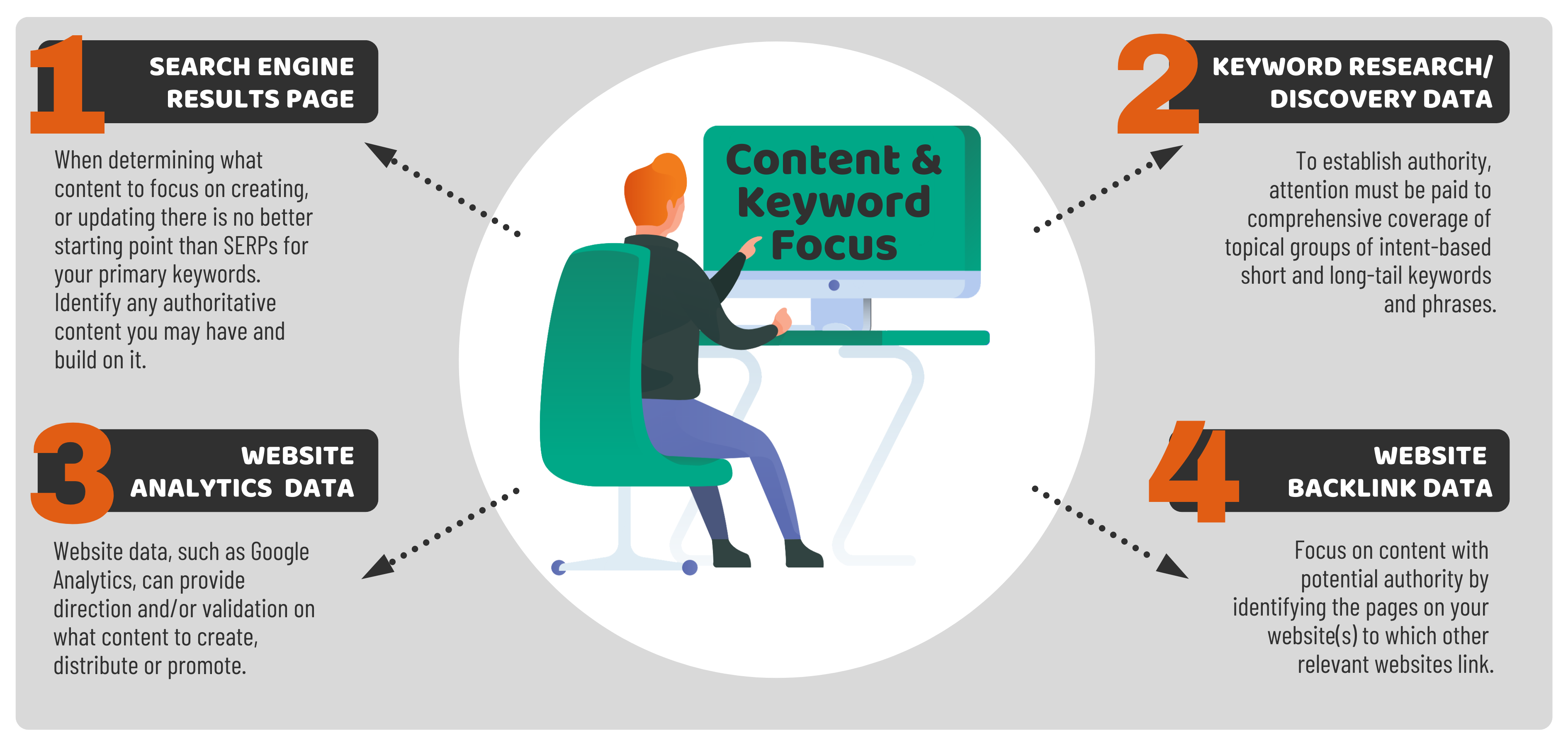Data makes the digital marketing world go round.
Those who commit to using it get to ride along, while those who don’t run the risk of getting left behind.
Analyzing data to identify where you have momentum can help you focus on the content and keywords that will provide the best chance of improving your website’s authoritativeness and organic visibility.
By now, I think we’ve all been told enough times by enough experts on the topic.
The key to any successful content marketing strategy, which will produce targeted, high-conversion traffic is the creation and distribution of relevant, quality content.
It’s no longer, and for that matter never has been, good enough to simply publish and share boatloads of random, keyword-stuffed content via your website, social media or other channels, in the hopes your target audience will find it, read, listen to or watch it, like it and share it.
Too often, the approach taken is to simply start creating “content” without a clear strategy, goals, or method of measuring success in mind.
This type of approach has led to the current glut of content.
This should come as a shock to no one.
Our websites, social feeds, and email inboxes are littered with confusing clickbait, misguided messages, bloated blogs, and downright awful articles.
We all read about focusing on quality over quantity, but still seem to get caught up in the latter in a race to dominate.
A Backlinko/BuzzSumo study analyzed 912 million blog posts (most, if not all those created across the web in 2018) to “better understand the world of content marketing right now.”
The number 912 million should be mind-boggling enough.
However, the study reveals the monumental challenge facing marketers.
As an example, 94% of content studied received no links and only 2% of all content had links from more than one website.
I reiterate: 2%.
And yes, links are still an important factor in Google’s organic search results algorithm.
Today, there is simply too much noise, regardless of the topic, so your content must stand out.
Furthermore, it must address the informational needs and intent of your desired audience.
Much has been written lately on creating appropriate content for each stage of the buyer’s journey – from awareness and consideration through to decision/conversion.
Consumers will ask different questions in different ways at each stage, as their knowledge and understanding of what they want and need evolves.
Who Wants Pizza?
Let’s say you want pizza for dinner. Who doesn’t?
But there are a whole bunch of different ways you can ask questions about pizza.
So what questions might you ask, depending on the evolution of your pizza needs?
- What is pizza?
- How do I make pizza?
- Where can I buy pizza near me?
- Who makes the best pizza?
- Who makes the cheapest pizza?
- Where can I order a gluten-free, veggie lovers pizza right now?
Now as the business owner on the other side of the counter, you need to make sure you have the appropriate answers for each of the questions you’re able to authoritatively answer.
Effective content marketers leverage data to help identify:
- Who their target is.
- Where they are.
- What they like.
- How to create the types of pizza content they are most likely to consume (pun fully intended) at each stage of their journey.
One popular approach is to identify or develop a pillar piece of content and then create clustered content around it grouped by shared topics and related subtopics.
All content is cross-linked for easy access, so no matter where their journey starts, searchers can find all of the relevant information within a couple of clicks.
This strategy offers the ability to fully cover a specific subject and every possible intent a user could have when searching on the topic as a single search often leads to several other questions requiring full answers.
In other words, you become an authority on the topic.
To start, there are four primary types of data around which you can build your content and keyword pillar strategy.

1. Search Engine Results Page (SERP) Data
When it comes to determining what content to focus on creating, there is no better starting point than SERPs for the primary keywords you want to be found for.
SERP data will help you to determine and take action on a few things:
What, If Any, Content Do You Have, Already Has Authority/Visibility Upon Which You Can Build Momentum?
In other words, which of your existing content (webpages, blog posts, PDFs, images, videos, etc.) maintains positions in the Top 20 search results.
Once identified there are a number of best practice steps you can take to further its momentum:
Conduct an Audit
If the content is a webpage or blog post, conduct a technical SEO, usability, and keyword page audit to ensure it is as fully optimized as it can be.
In particular, revisit:
- Title Tags, Heading Tags, Meta Descriptions (including the addition of relevant Calls to Action where appropriate).
- Image Alt Tags (where images are central to the content).
- Schema markup (where applicable).
Remember: Just because a page ranks well, does not mean it is fully optimized and validating this will serve to strengthen its position.
Create More Complementary Content
Create more, keyword-rich, and varied pieces of content to complement and link to or from the existing.
This will have the effect of bolstering and/or building on its authority.
Ensure the Piece Is Up-to-Date
Look to refresh and/or expand upon the original piece with updated information, images, video or other rich components to enhance its value and appeal.
What Types of Content Rank Well for Your Keywords?
Is the top 20 dominated by product pages, blogs, videos, images, social posts or something else?
This will obviously tell you something about the types of content deemed relevant and yours should reflect the same.
If social posts are appearing in your search results, this may be a strong clue as to where it would be prudent to share the content you create.
Gary Henderson proposes a six-step process for engaging your organic search traffic on Facebook in his Search Engine Journal article.
How Much & What Types of Competition Do You Have?
Before you decide to focus on being found for any keyword or group of keywords, you should determine:
- What level of competition you are up against.
- As best you can, what level of effort may be required to effectively compete for visibility.
For example, if you play in a B2C product category whose top 10 organic search positions are dominated by big-box store product listings, you’ll probably want to focus your attention on working with those big-box vendors and/or identifying longer tail related keywords for which they may not appear.
While we’re on the topic of competition, it also makes sense to reverse engineer some of your primary competitors’ top-performing pages to determine what factors (beyond general domain authority) may be influencing their ability to rank.
Perform the same technical SEO, usability, and keyword page audit you would on your own to see what they may be doing right.
What Opportunities May There Be to Piggyback on the Authority of Other Content Creators?
SERPs are arguably your best source of potential links.
Scanning the search results for your primary keywords may reveal valuable places to share content; think directories, industry publications, review sites, influencer blogs, etc.
The pages and domains showing up for your keywords are, by definition, authoritative link sources.
Naturally, you will want to find domains which are not directly competitive, and securing space here may not be a simple or free process.
But advertising or publishing unique, relevant content on high-ranking pages can have the dual effect of boosting both your visibility and authority.
2. Keyword Research / Discovery Data
We can’t really have a conversation about content and organic visibility without talking about keywords.
Content is, after all, based on keywords and they are still the primary way search queries are performed; including voice search.
However, the focus of these conversations has decidedly changed over the last several years.
In order to truly establish authority, attention must be paid to comprehensive coverage of topical groups of short and long-tail keywords and keyword phrases.
Remember the aforementioned discussion around content pillars and clusters.
Keyword research is a combination of:
- The validation of the keywords you believe to be the right ones to focus on and topical variations thereof.
- The discovery of new keyword opportunities you may not have considered based on organic search behavior and/or competitive analysis.
There’s a myriad of free and paid keyword research tools available.
They can help save time and provide some direction by highlighting potential opportunities based on metrics like:
- Search volume.
- Relevance.
- Organic traffic.
- Click-through rate.
- Competition.
To begin, Google Search Console search query data certainly can be referenced for validation of which keywords you maintain positions and receive impressions/clicks for.
However, regardless of the tool, this data should be used as a relative measure of the value of your keywords.
Effective keyword research requires SEOs and content creators to:
Review the data provided by these solutions.
Critically analyze it relative to existing keywords/content.
Incorporate any newly qualified keywords and phrases into new or existing content.
A key component of the analysis is ensuring any chosen keywords and the content they support address the search intent of the target audience (i.e., provide clear answers to searchers’ questions).
3. Website Analytics Data
Analytics data (and we’ll look specifically at Google Analytics here) can likewise provide direction and/or validation on which content to create, distribute, and/or promote.
As a starting point, you can review organic search landing page data to determine the top entrance pages from this channel.
These pages are naturally those which have established some search visibility.
Further refine this list of “priority” pages by identifying those with relatively low bounce rates, high average session duration, and pages per session.
In other words, pages which exhibit higher engagement.
If you have set up goal conversions in GA, you can also assign value to landing pages based on the goal completions they’ve influenced.

Landing page data is also available via Google Search Console (GSC), including impressions, clicks, click-through rate, and average position.
GSC will sometimes reveal content items (such as PDFs or images) which are not typical landing pages as tracked in Google Analytics, but also represent visibility opportunities.
As discussed with SERP data, all of the landing pages reported here, or at least the top pages depending on the volume and available resources, should undergo a thorough technical, usability, and keyword audit to ensure they are as optimized as they can be.
4. Inbound Link Data
Another way to focus on content with potential authority is to identify the pages on your website(s) to which other relevant websites link.
These pages, by definition, have some level of authority, at least in the eyes of those who’ve chosen to link to them and, by extension, the search engines provided they’ve been indexed.
Not all links are created equal.
So you’ll want to understand which links are follow versus no-follow and which domains have both relevance and authority.
If you have 100 inbound links to a page, but 99 of them are from low quality, spammy sites you are receiving little to no value.
Conversely, one inbound link from a highly relevant, authoritative site is worth its weight in organic authority gold.
As with keywords, there are lots of options for identifying where you have existing links, but Google Search Console Top Linking Sites and Google Analytics referrals data are great places to start.


Build on Your Momentum – Deliver the Pizza
We can all agree there are lots, if not too much, data available for those who take the time to leverage it.
In an increasingly chaotic world, it’s more important than ever to find quick wins and easy ways to focus our attention.
My humble suggestion is to begin by building on and around your strengths.
Use readily available keyword, analytic, and link data to identify your most authoritative content based on keywords you want to be found for.
Update or create your pillar content items around these primary keywords and then complement it with rich, comprehensive answers to all of the possible questions your audience has beyond their initial query.
Give them the best-damned pizza they’ve ever had!
More Resources:
- 5 Tips for a Data-Driven Content Strategy That Increases Conversions
- Content Marketing: The Ultimate Beginner’s Guide to What Works
- What Is Content Marketing & Why It Matters
Image Credits
In-Post Image: Mintent
All screenshots taken by author, August 2020





![[SEO, PPC & Attribution] Unlocking The Power Of Offline Marketing In A Digital World](https://www.searchenginejournal.com/wp-content/uploads/2025/03/sidebar1x-534.png)